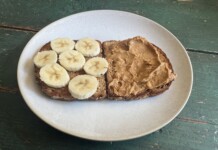By Breanne Nalder, MS. and Katherine Beals, PhD, RD, FACSM, CSSD — I have learned about the importance of bones the hard way! At the mere age of 25, a bone scan revealed that I had the skeletal equivalent of a 60 year old woman. My risk of suffering an osteoporotic fracture was significantly increased, which is concerning for a cyclist, particularly one who has had (and continues to have) her fair share of crashes! Not surprisingly, this discovery sparked my interest in the factors that impact bone health and helped to chart my educational endeavors.
Long story short, I enrolled in a Nutrition Master’s program at the University of Utah where I had a chance to learn about bone physiology as well as how important both exercise and nutrition are to optimal bone health and how many of the practices of elite athletes actually compromise their bones! The culmination of this education was the completion of my thesis project (examining energy availability and bone density in male cyclists) under the direction of Dr. Katherine Beals, who has been studying the effects of diet and exercise on bone health in female athletes for over a decade. What follows is a brief synopsis of what I have learned from my coursework and thesis project along with recommendations for optimizing your bone health.
Dem bones, dem bones
Over 200 bones make up the human skeleton…very important, but often taken for granted. The 3 major roles of bones are to give our bodies structure, to protect our delicate internal organs from damage, and to act as a storage facility for minerals that are vital for life, especially calcium. Look beyond the hard outer shell, and you’ll see that bone is actually a living tissue that is constantly being broken down and reformed– a process known as “remodeling”. Through our 20s and perhaps early 30s, the amount of bone formed is greater than the amount of bone broken down; thus, our bones are becoming more dense and stronger. As we get older (particularly past the age of 50) the balance shifts such that the amount of bone being broken down exceeds the amount of bone being formed and, thus, our bones lose density and become weaker (and more susceptible to fracture). But, age is not the only thing that can affect the balance between bone formation and bone breakdown thereby affecting bone density. Hormones, exercise, and nutrition all have independent and synergistic effects on bone health. While there are a number of hormones that are involved in bone remodeling, one of the most important hormones for both women and men is estrogen. Inadequate estrogen production results in decreased bone formation and increased bone breakdown causing loss of bone density and increased risk of fractures. When it comes to exercise, it appears as though only those types that involve significant impact (e.g., jumping or landing) or muscular strain (e.g., resistance training) stimulate bone formation and, thus, improve bone density. Finally, the nutritional factors that affect bone health go way beyond calcium. Adequate energy (calories), protein, vitamins D, A, C and K and the minerals phosphorous, magnesium, potassium and zinc are all essential for promoting bone formation.
No bones about it: Cyclists are at high risk for low bone density
Research consistently shows that cyclists not only have lower bone densities than athletes participating in other sports, but also than age-matched sedentary controls. The reasons for this are likely three-fold. First, cycling is a low impact sport, which does not appear to significantly stimulate bone formation. Second it is a common practice among cyclists to attempt weight loss via calorie restriction in the quest to obtain an optimal “power-to-weight” ratio. This calorie restriction can lead to energy deficits and nutritional deficiencies (and, among female cyclists, menstrual dysfunction and resulting estrogen deficiencies) all of which decreases bone formation. Finally, many cyclists avoid or limit resistance training and plyometric jump training for fear of adding “weight” to their frames which is unfortunate because these types of exercises are particularly potent stimuli for bone formation. Not only can these practices result in low bone density and increased fracture risk but they can negatively impact performance as well. Inadequate energy intake can lead to an earlier onset of fatigue and compromise recovery and training adaptations.
Feeding your skeleton
We all know how important calcium is in the structure of our bones, but calcium is also critical for other bodily functions, such as nerve transmission, blood clotting, regulation of blood pressure and muscle contraction. There are only two places our bodies can get calcium: the food we eat and our bones. If your diet is low in calcium, where do you think your body is going to get the calcium it needs to keep your nerves firing and your muscles (including your heart muscle) contracting? You guessed it, your bones. Thus, to minimize losses of calcium from the bones, you need to consume adequate calcium on a daily basis. That means 1200-1500 mg/day if you are female and 1000-1200 mg/day if you are male.
Foods rich in calcium include dairy products, dark leafy green vegetables, sardines (with bones), almonds and fortified grains and cereals. It’s pretty easy to get all the calcium you need from foods. For example: a cup of milk on your morning cereal has approximately 1 serving (note that milk substitutes, such as soy or almond, are fortified with calcium, so are great sources for anyone who does not tolerate dairy). Then with your lunch you may have a side spinach salad, and perhaps string cheese or yogurt for a snack. And finally, for dinner you may cook up a dish that includes 4-5 oz. of salmon (leave the bones in!) and a side of broccoli… Voila! You’ve met your daily needs of calcium.
As noted earlier, calcium isn’t enough on its own to ensure healthy bones and prevent osteoporosis; Vitamin D is essential in this equation. There are two primary sources of vitamin D and fortunately for us, one of those sources is extremely plentiful in Utah and won’t cost you a cent…the sun! Special cells in our skin produce vitamin D when they are exposed to the sun, and most cyclists spend more than enough time in the sun to synthesize all the vitamin D they need (note: sunscreens inhibit vitamin D production). There are very few natural food sources that contain significant amounts of vitamin D, though it is found in mushrooms and cold-water fish such as salmon, mackerel, oysters and shrimp. Nonetheless, many of the same foods that are rich in calcium (e.g., diary products and dairy substitutes) are also fortified with vitamin D. Other nutrients essential for bone health include the minerals magnesium, potassium, phosphorous and zinc along with vitamins A, K and C. Luckily, fruits, vegetables, legumes and whole grains are plentiful sources of these nutrients. Also essential but often overlooked for optimal bone health are adequate calories and protein. Calorie requirements must be determined on an individual basis because they are dependent on a number of factors including they cyclists weight, body composition, gender, training schedule, etc. The recommended amount of protein for an endurance athlete is 1.2-1.6 g/kg of body weight per day. Cyclists who are engaging in intense and/or prolonged training or who are actively trying to lose weight should aim for the higher end of the protein range.
The Bottom Line
It’s never too late to improve your bone health through proper diet and exercise. Consuming a nutrient dense and energy sufficient diet, getting a healthy dose of sunshine, and engaging in weight bearing exercises and/or resistance training will go a long way towards supporting your bones so that they can best support you!
Breanne Nalder, MS recently completed here master’s degree in nutrition with an emphasis in sports dietetics at the University of Utah and is a competitive CAT 1,2,3 cyclist.
Katherine Beals, PhD, RD, FACSM, CSSD is an associate professor (clinical) in the Division of Nutrition at the University of Utah. She is a registered dietitian, a certified specialist in sports dietetics and a fellow of the American College of Sports Medicine.











